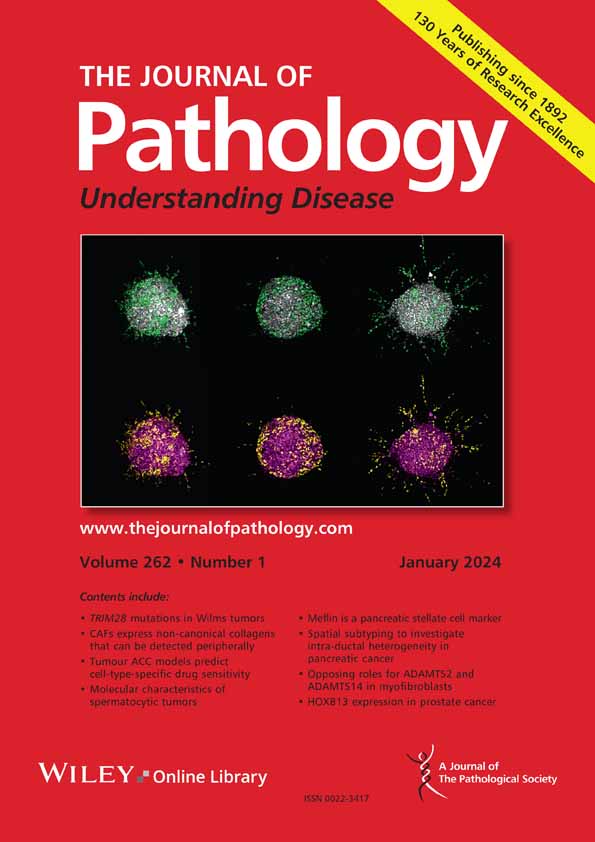Pyung Hun Park, Lauren E Israel, Michael H Alexander, Grace Tartaglia, Harvey G South, Suhao Han, Joseph M Curry, Adam J Luginbuhl, Andrew P South
下载PDF
{"title":"部分emt细胞状态与头颈部鳞状细胞角质形成细胞侵袭的单细胞模式相关。","authors":"Pyung Hun Park, Lauren E Israel, Michael H Alexander, Grace Tartaglia, Harvey G South, Suhao Han, Joseph M Curry, Adam J Luginbuhl, Andrew P South","doi":"10.1002/path.6454","DOIUrl":null,"url":null,"abstract":"<p>The presence of a single metastatic lesion significantly decreases overall survival in patients with head and neck squamous cell carcinoma (HNSCC), and invasion of malignant keratinocytes is one of the initial steps required for HNSCC metastasis. Histological grading of tumor cell invasion predicts outcome in HNSCC, yet the molecular factors that determine the extent of invasion, and subsequent grading are not fully understood. Using a 3D organ culture model and multiple patient-derived HNSCC keratinocytes representing all major anatomical subsites of the disease, we identified a range of cell states that represent a continuum of epithelial-to-mesenchymal (EMT) characteristics. We also demonstrated how these cell states change in response to TGF-beta stimulation and co-culture with cancer-associated fibroblasts in organ cultures. Using 3D culture models that recapitulate the pattern of invasion seen in primary tumors from which the keratinocytes were derived, we identified distinct clusters of partial-EMT marker expression in individual patient HNSCC keratinocyte populations. Partial-EMT transcription factors were correlated with separate invasive characteristics, and we demonstrated that ZEB2 (a known EMT driver) and HIC1 (a novel EMT driver) are central nodes in HNSCC keratinocyte invasion. Collectively, our findings refine the concepts of partial-EMT and tumor cell invasion, and identify potential therapeutic targets for future development. © 2025 The Author(s). <i>The Journal of Pathology</i> published by John Wiley & Sons Ltd on behalf of The Pathological Society of Great Britain and Ireland.</p>","PeriodicalId":232,"journal":{"name":"The Journal of Pathology","volume":"267 1","pages":"92-104"},"PeriodicalIF":5.2000,"publicationDate":"2025-07-30","publicationTypes":"Journal Article","fieldsOfStudy":null,"isOpenAccess":false,"openAccessPdf":"https://www.ncbi.nlm.nih.gov/pmc/articles/PMC12313228/pdf/","citationCount":"0","resultStr":"{\"title\":\"Partial-EMT cell state correlates with single cell pattern of invasion in head and neck SCC keratinocytes\",\"authors\":\"Pyung Hun Park, Lauren E Israel, Michael H Alexander, Grace Tartaglia, Harvey G South, Suhao Han, Joseph M Curry, Adam J Luginbuhl, Andrew P South\",\"doi\":\"10.1002/path.6454\",\"DOIUrl\":null,\"url\":null,\"abstract\":\"<p>The presence of a single metastatic lesion significantly decreases overall survival in patients with head and neck squamous cell carcinoma (HNSCC), and invasion of malignant keratinocytes is one of the initial steps required for HNSCC metastasis. Histological grading of tumor cell invasion predicts outcome in HNSCC, yet the molecular factors that determine the extent of invasion, and subsequent grading are not fully understood. Using a 3D organ culture model and multiple patient-derived HNSCC keratinocytes representing all major anatomical subsites of the disease, we identified a range of cell states that represent a continuum of epithelial-to-mesenchymal (EMT) characteristics. We also demonstrated how these cell states change in response to TGF-beta stimulation and co-culture with cancer-associated fibroblasts in organ cultures. Using 3D culture models that recapitulate the pattern of invasion seen in primary tumors from which the keratinocytes were derived, we identified distinct clusters of partial-EMT marker expression in individual patient HNSCC keratinocyte populations. Partial-EMT transcription factors were correlated with separate invasive characteristics, and we demonstrated that ZEB2 (a known EMT driver) and HIC1 (a novel EMT driver) are central nodes in HNSCC keratinocyte invasion. Collectively, our findings refine the concepts of partial-EMT and tumor cell invasion, and identify potential therapeutic targets for future development. © 2025 The Author(s). <i>The Journal of Pathology</i> published by John Wiley & Sons Ltd on behalf of The Pathological Society of Great Britain and Ireland.</p>\",\"PeriodicalId\":232,\"journal\":{\"name\":\"The Journal of Pathology\",\"volume\":\"267 1\",\"pages\":\"92-104\"},\"PeriodicalIF\":5.2000,\"publicationDate\":\"2025-07-30\",\"publicationTypes\":\"Journal Article\",\"fieldsOfStudy\":null,\"isOpenAccess\":false,\"openAccessPdf\":\"https://www.ncbi.nlm.nih.gov/pmc/articles/PMC12313228/pdf/\",\"citationCount\":\"0\",\"resultStr\":null,\"platform\":\"Semanticscholar\",\"paperid\":null,\"PeriodicalName\":\"The Journal of Pathology\",\"FirstCategoryId\":\"3\",\"ListUrlMain\":\"https://pathsocjournals.onlinelibrary.wiley.com/doi/10.1002/path.6454\",\"RegionNum\":2,\"RegionCategory\":\"医学\",\"ArticlePicture\":[],\"TitleCN\":null,\"AbstractTextCN\":null,\"PMCID\":null,\"EPubDate\":\"\",\"PubModel\":\"\",\"JCR\":\"Q1\",\"JCRName\":\"ONCOLOGY\",\"Score\":null,\"Total\":0}","platform":"Semanticscholar","paperid":null,"PeriodicalName":"The Journal of Pathology","FirstCategoryId":"3","ListUrlMain":"https://pathsocjournals.onlinelibrary.wiley.com/doi/10.1002/path.6454","RegionNum":2,"RegionCategory":"医学","ArticlePicture":[],"TitleCN":null,"AbstractTextCN":null,"PMCID":null,"EPubDate":"","PubModel":"","JCR":"Q1","JCRName":"ONCOLOGY","Score":null,"Total":0}
引用次数: 0
引用
批量引用






 求助内容:
求助内容: 应助结果提醒方式:
应助结果提醒方式:


